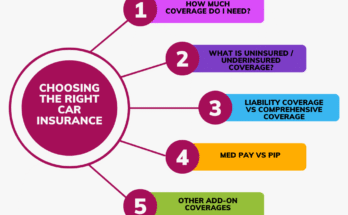Understanding House Insurance: What You Need to Know
Homeownership is one of life’s major milestones, but along with the pride of owning a home comes the responsibility of protecting it. House insurance, also known as homeowners insurance, is one of the most essential financial tools available to safeguard your investment. It covers damage to your property, protects your belongings, and offers liability protection in case of accidents. But what exactly does house insurance cover, how does it work, and why is it important?
In this article, we will explore the basics of house insurance, the types of coverage available, what it typically includes and excludes, how premiums are calculated, and tips for choosing the right policy.
What Is House Insurance?
House insurance is a policy that provides financial protection against loss or damage to your home and personal property due to unforeseen events such as fires, storms, theft, and other disasters. It also covers legal liability if someone is injured on your property.
In many countries, house insurance is not legally required, but if you have a mortgage, your lender will almost always require you to have it. This ensures that both you and the lender are protected if something happens to the property.
Types of House Insurance Coverage
House insurance usually consists of several types of coverage bundled into a single policy. These include:
1. Dwelling Coverage
This part of the policy covers the structure of your home, including walls, roof, and built-in appliances, if damaged by a covered peril such as fire, hail, or vandalism.
2. Other Structures
This includes coverage for structures not attached to your house, such as garages, sheds, fences, and guesthouses.
3. Personal Property
This section protects the contents of your home, including furniture, electronics, clothing, and other personal items. If these items are stolen or damaged by a covered event, your policy will help pay to repair or replace them.
4. Liability Protection
If someone is injured on your property and you’re found legally responsible, liability protection helps pay for medical expenses, legal costs, and damages.
5. Additional Living Expenses (ALE)
If your home is rendered uninhabitable due to a covered event, ALE coverage pays for temporary living expenses such as hotel stays, meals, and transportation while your home is being repaired.
What House Insurance Typically Covers
Most standard policies cover a range of events, known as “perils.” Common perils include:
- Fire and smoke
- Lightning strikes
- Windstorms and hail
- Theft and vandalism
- Explosion
- Falling objects
- Weight of snow or ice
- Water damage from burst pipes or accidental overflows
However, not all events are automatically covered, and some may require additional coverage.
What’s Not Covered?
Understanding exclusions is just as important as knowing what’s covered. Common exclusions include:
- Floods: Damage from flooding is not typically covered. Homeowners in flood-prone areas must purchase separate flood insurance.
- Earthquakes: Like floods, earthquakes require separate coverage.
- Negligence or poor maintenance: If damage is due to neglect or lack of maintenance, insurance won’t cover it.
- Pest infestations: Termites, rodents, and mold due to poor upkeep are generally not included.
- Intentional damage: Any damage caused intentionally by the homeowner is not covered.
Always read the fine print of your policy to understand what is and isn’t included.
How Are Premiums Determined?
House insurance premiums—the amount you pay monthly or annually—are based on several factors, including:
- Location: Areas prone to natural disasters, crime, or high construction costs tend to have higher premiums.
- Home value and construction type: Larger homes and those built with expensive materials cost more to insure.
- Coverage limits and deductibles: Higher coverage limits and lower deductibles will increase your premium.
- Claims history: Homeowners with previous claims may face higher rates.
- Security features: Having alarms, smoke detectors, and other safety devices may reduce your premium.
Choosing the Right Policy
Here are some tips for selecting a house insurance policy that suits your needs:
1. Assess Your Needs
Consider the replacement cost of your home, the value of your belongings, and any potential risks in your area. Make sure the policy provides enough coverage to fully rebuild your home if necessary.
2. Understand the Types of Policies
There are different policy types such as HO-1, HO-2, and HO-3, each with varying levels of coverage. The HO-3 policy is the most common and offers comprehensive coverage for homeowners.
3. Compare Quotes
Get quotes from multiple insurance providers and compare premiums, coverage options, and deductibles. Don’t automatically choose the cheapest option—make sure the coverage fits your needs.
4. Check for Discounts
Many insurers offer discounts for bundling home and auto insurance, installing safety features, or having no recent claims.
5. Review the Fine Print
Be sure to understand the exclusions, limitations, and conditions of the policy before committing.
Making a Claim
If you suffer a loss, here’s how to make a claim:
- Document the damage by taking photos or videos.
- Contact your insurer as soon as possible to report the claim.
- Complete the necessary forms provided by the insurer.
- Schedule an inspection with the insurance adjuster.
- Keep receipts if you need to make temporary repairs or relocate.
Prompt communication and clear documentation can help speed up the claims process.
The Importance of Regular Reviews
Your insurance needs may change over time. Renovations, purchasing valuable items, or lifestyle changes can all impact your coverage requirements. It’s wise to review your policy annually with your insurer to ensure you’re adequately protected.
Final Thoughts
House insurance is more than a financial product—it’s peace of mind. A home is often the largest investment a person will make, and protecting it with the right insurance policy is a smart, necessary decision. From repairing storm damage to replacing stolen valuables or defending against liability claims, house insurance offers broad protection that can save you thousands of dollars in the long run.
Make sure you understand the different types of coverage, know what’s excluded, and choose a policy tailored to your situation. With the right insurance in place, you can enjoy your home with greater confidence and security.



